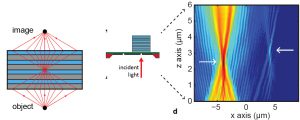Demonstration of a flat lens for ultraviolet light
AMOLF researchers have created a new optical lens that is flat, rather than curved like a traditional glass lens. The lens operates by the mechanism of negative refraction, that was first predicted by Veselago in 1968 and focuses ultraviolet light to a diffraction-limited spot. It can find applications in ultracompact optical storage devices and ultrasmall microscopy instruments.
Ever since its first prediction by Veselago in 1968, the concept of a flat lens that focuses light by negative refraction has intrigued optical scientists. Such a flat lens has no optical axis, allowing parallel imaging on a large scale, and has a focal distance smaller than an optical wavelength, enabling many new applications in imaging. However, negative refraction does not exist in naturally occurring materials. Hyperbolic metamaterials have been developed that exhibit negative refraction, but are unsuited for the fabrication of a practical flat lens, as their anisotropy leads to strong aberrations, and hence strongly blurred images.
In a new article, published online on June 8th in Optica, the researchers present a new design for a flat lens, inspired by the hyperbolic metamaterial design, in which the dispersion of light was engineered in such a way that the lens emulates the response of an isotropic negative refractive index equal to n=-1, avoiding aberrations. The researchers fabricate the flat lens that operates in the UV at lambda=364 nm using a silver/titanium-dioxide single-periodic thin film multilayer structure. Using confocal microscopy they observe a clear focus positioned only 350 nm away from the flat lens surface, in very good agreement with analytical calculations and numerical simulations. Group leader Albert Polman: “It surprised us that such a simple anisotropic layered structure can have so many isotropic characteristics. Using an extremely simple design we can send light in the opposite direction, clearing the way to multiple innovating applications.”
Figure (left) When light enters a structure made of very thin alternating layers of silver and titanium dioxide (blue and gray stripes), negative refraction takes place, allowing the structure to focus light coming from multiple angles and thus act as a lens. Figure (right) Measurement of the light focus above the lens. Light (wavelength 364 nm) is incident from the bottom and forms an image on top of the multilayer, as measured using a confocal microscope.
Reference
Planar metal/dielectric single-periodic multilayer UV flat lens, R. Maas, J. van de Groep, en A. Polman, Optica,3, 6, pp. 592-596 (2016) | DOI: 10.1364/OPTICA.3.000592



